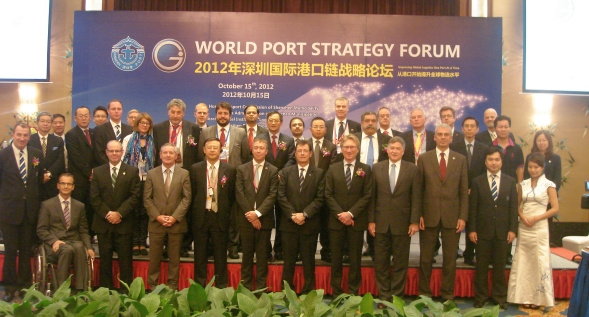[dopts id=”104″]
DEPLOYING A CHAINPORT MODEL BETWEEN SISTER PORTS
The 2011 forum gave the Institute a mandate to research the case for formal cooperation between port authorities and the potential to develop a “Chain Port” model. The 2012 forum will present our preliminary findings which point to a real opportunity for a formal alliance of seaports to emerge.

Kieran Ring
CEO
Global Institute
of Logistics __________________
FORUM MODERATOR
Last year’s World Port Strategy Forum (WPSF) discussed the Institute’s “Operation Port Unity – Improving Global Logistics One Port at a Time” research into global ports, and examined how port communities are meeting the demands of full integration into the global supply chain. The event was also an opportunity for participating port authorities to share their work illustrating their emergence as port logistics strategists facilitating the development of an integrated port community.
The 2011 forum established that port authority “Thought Leaders” no longer see their role as been of just that of a landlord, now viewing themselves as “Economic Strategists” on behalf of the port community and the wider economic region. Port Authority CEO’s now focus on the quality of service the shipping line’s customer, the beneficial cargo owners and non vessel operating companies receive from the port and its stakeholders as a whole. They believe that by focussing on overall service level quality by the port community as a whole increase throughput.
The 2011 forum gave the Institute a mandate to research the case for formal cooperation between port authorities and the potential to develop a “Chain Port” model. The ports of Shenzhen, Zeebrugge and Virginia, who are already sister ports agreed to participate formally in the research program.
The Sister Port agreements between Institute members acted as the perfect foundation for our research, which examined how to develop “chain” relationships between ports and its possible impact on global supply chains. The Ports industry will not be the first sector to ally for competitive advantage, indeed our industry is only too aware of how consortia and alliances between container shipping lines have changed the landscape in that arena. Alas most of the efficiencies and economies of scale achieved by this group accrue to themselves and very rarely to their customer base.
The airline industry driven by a more customer facing model proved to be a more comparable benchmark for our research. Star Alliance very quickly followed by One World, Skyteam and x have proven that short of merger and acquisition (legally forbidden in that arena and for the most part in ours) allying for advantage can have long and lasting positive outcomes.
The 2012 forum will present our preliminary findings which point to a real opportunity for a formal alliance of seaports to emerge.
Sister Port agreements are the ideal foundation to develop “chain” relationships between ports helping to optimize the port-centric logistics aspect of global supply chain.
The Institute traces the origin of Port Centric Logistics back here to South China and the Port of Shenzhen and pinpoints the local port community as the Pioneers in shaping both the business model and best practices that have come to shape port centric logistics globally.
Shenzhen is now embracing a new vision which it is driving through a sister port program which has seen it create formal relationships with 16 of the worlds leading port communities through their respective authorities. Assisted by the Institute, the intention is over time to strengthen these alliances, firstly bilaterally and in the future multilaterally.
The World Port Strategy Forum has been established as a result of these efforts and will provide the platform through which like minded ports from across the world can “Share With, Learn From & Benchmark With Each Other” in pursuit of greater innovation in and better delivery of port related services to the container supply chain.
HOST PORT FOR WPSF 2012 SHENZHEN PORT AUTHORITY
The Port of Shenzhen has long recognised the value of Sister Port relationships, and our support of the World Port Strategy Forum is testament to our desire to go beyond such Sister Port relationships and achieve even deeper collaboration.Forums such as this one are key milestones on this journey. While we may think a myriad of issues divide us as Port Authorities and Port Communities, we believe that our shared values unite us. Key values that we believe are indicative of the Port Authority of the future, and what a “Chain Port” model could be developed upon.
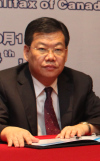
HUANG MIN
Chairman
Shenzhen Transport
Commission
____________
CONFERENCE CHAIRMAN
The 2012 World Port Strategy Forum will bring you the very latest thinking and sharing of knowledge from port communities around the world.In recent years we have witnessed the impact of globalization on Shipping Lines and Terminal Operators. We are interested in the next part of this trend – namely the globalization of Port Authorities. This is all the more important when you consider the following salient realisation made by the Organisation for Economic Co-operation and Development (OECD) in their ‘Port competition and hinterland connections’ report:
“From the ports point of view, the main consequence of developments in supply chains is that their market power has declined.Ports operate in an increasingly competitive environment within their range as well as in their function as nodes in supply chains increasingly prone to switch routings (route competition).”
This realisation has catalysed new thinking within global ports, as they migrate from hardware-based and infrastructure-based thinking to a more knowledge-based approach while re-evaluating their role within the wider supply chain. This understanding of the importance of supply chain integration may even lead to the emergence of a group of ports who approach these challenges as a collective, in essence what we call “Chain Ports”.
The Port of Shenzhen has long recognised the value of Sister Port relationships, and our support of the World Port Strategy Forum is testament to our desire to go beyond such Sister Port relationships and achieve even deeper collaboration.Forums such as this one are key milestones on this journey. While we may think a myriad of issues divide us as Port Authorities and Port Communities, we believe that our shared values unite us. Key values that we believe are indicative of the Port Authority of the future, and what a “Chain Port” model could be developed upon.
For today let us focus on our shared values, as we discuss and resolve issues that stand in the way of a truly integrated global maritime supply chain – with ports occupying their rightful place at its heart.
Mr. Huang Min
Director General Transport Commission of Shenzhen Municipality
(Ports Administration)
THE AGENDA FOR THE 2011 WORLD PORT STRATEGY FORUM
Meeting Format: A Forum not a Conference
The format for the meeting is designed to create a flow of conversation around the central theme of DEPLOYING A CHAINPORT MODEL BETWEEN SISTER PORTS. Unlike the traditional conference format, the meeting will be held in forum style, where all 25 guest experts will engage with the subject throughout the entire day. The narrative is informed by a keynote address followed by a series of short presentations at strategic intervals throughout the forum. The presentations given by recognized industry experts act as segues to the next area to be debated. On completion, the subject is discussed and debated in the forum, before delegates are invited to engage. Each subject is supported by a series of talking points which are agreed in advance through local and global research and in particular in coordination with delegates and experts. The talking points provide a roadmap, at end of which we hope to have exhausted the subject from all angles and points of view.
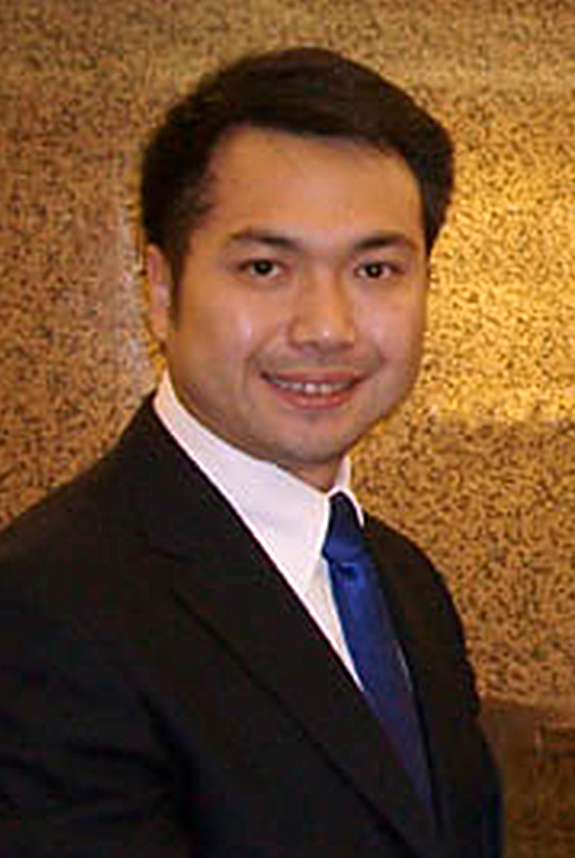
YANG LEI
China Director
Global Institute of Logistics
China
_____________________
WORLD PORT STRATEGY FORUM
PRODUCER
______________________
Born and now based in Beijing, Mr. Yang Lei (William) was appointed the Institute’s China Director in September 2010.
[dopts id=”183″]
CLICK IMAGE TO VIEW CONFERENCE AGENDA & PANEL OF EXPERTS
OVERVIEW & INTRODUCTION TO THE FORUM
KIERAN RING CEO GLOBAL INSTITUTE OF LOGISTICS

KIERAN RING
CEO
Global Institute
of Logistics __________________
FORUM MODERATOR
[dopts id=”189″]
CLICK IMAGE TO VIEW PRESENTATION
BIOGRAPHY:
[/expandsub2]
LOGISTICS DEVELOPMENT IN SHENZHEN PORT
MA YONGZHI PORT OF SHENZHEN
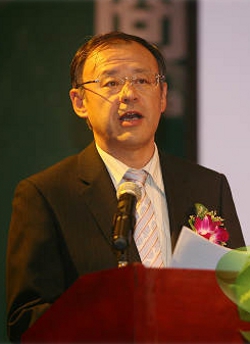
MA YONGZHI
Deputy Director General
Shenzhen Port Authority
China
_____________________
GLOBAL INSTITUTE OF LOGISTICS
CHINA CHAPTER
In 1987 Ma Yongzhi joined the Chinese Communist Party, and has gone on to become a dedicated and loyal servant to the Chinese people. Throughout his distinguished career in public service he has held a variety of diverse roles, which have given him a wealth of experience that he now brings to his current position of Deputy Director General of Shenzhen Port Authority.He has served as the City Bus Company Engineer, Director and Secretary Municipal Transportation Bureau of Safety Director City Department of Transportation Safety Director, Committee Member, and Deputy Director.
[dopts id=”94″]
[dopts id=”190″]
CLICK IMAGES TO VIEW DOCUMENTS
YANTIAN INTERNATIONAL CONTAINER TERMINALS GLOBAL “BEST IN CLASS”
PROFESSOR KEN TSE FOUNDING GENERAL MANAGER
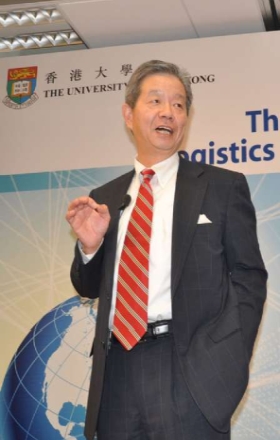
PROFESSOR KEN TSE
Retired
__________________
Global Institute of Logistics
FOUNDER
[dopts id=”191″]
CLICK IMAGE TO VIEW PRESENTATION
BIOGRAPHY:
JOE RUDDY PRESIDENT VIRGINIA INTERNATIONAL TERMINALS
MY VISION FOR THE INDUSTRY
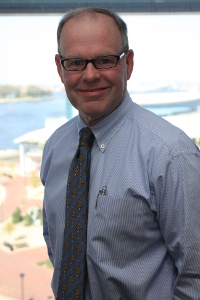
JOE RUDDY
President
Virginia International Terminaks
U.S.A
_____________________
MEMBER
GLOBAL INSTITUTE OF LOGISTICS
NORTH AMERICA CHAPTER
[dopts id=”184″]
CLICK IMAGE TO VIEW PRESENTATION
BIOGRAPHY:
THE VALUE OF SISTER PORT AGREEMENTS IN INTERNATIONAL PORT RELATIONS – A HAMBURG PERSPECTIVE
WOLFGANG HURTIENNE MANAGING DIRECTOR HAMBURG PORT AUTHORITY

WOLFGANG HURTIENNE
Managing Director Hamburg Port Authority
Germany
_________________
MEMBER
GLOBAL INSTITUTE OF LOGISTICS
EUROPEAN CHAPTER
[dopts id=”185″]
CLICK IMAGE TO VIEW PRESENTATION
BIOGRAPHY:
THE ROLE OF PORTS IN CHAIN LOGISTICS
VINCENT DE SAEDELEER VICE PRESIDENT ZEEBRUGGE PORT AUTHORITY
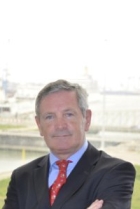
VINCENT DE SAEDELEER
Vice President
Zeebrugge Port Authority
Belgium
_____________________
MEMBER
GLOBAL INSTITUTE OF LOGISTICS
EUROPE CHAPTER
[dopts id=”186″]
CLICK IMAGE TO VIEW PRESENTATION
BIOGRAPHY:
INFORMATION SHARING BETWEEN CHAINPORTS
ALAN MURPHY PARTNER SEAINTEL MARITIME ANALYSIS

MR. ALAN MURPHY
PARTNER
Seaintel Maritime Analysis
Denmark
_____________________
KNOWLEDGE PARTNER
GLOBAL INSTITUTE OF LOGISTICS
[dopts id=”187″]
CLICK IMAGE TO VIEW PRESENTATION
BIOGRAPHY:
NETWORKING CHAINPORTS USING THE PORT COMMUNITY SYSTEM
SRIKANTH PALEM REDDY FOUNDER 4SOFT

SRIKANTH REDDY
Founder
4Soft Solutions
India
_____________________
ADVISOR
GLOBAL INSTITUTE OF LOGISTICS
[dopts id=”188″]
CLICK IMAGE TO VIEW PRESENTATION
BIOGRAPHY:
E-TECHNOLOGY TO ENABLE VISIBILITY OF CONTAINERS IN THE PORT COMMUNITY
BAO QIFAN STATE-RANK EXPERT, ENGINEER, ECONOMIST SIPG
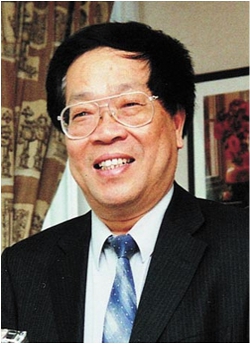
Mr. BAO QUIFAN
Engineer & Economist
Shanghai Int. Port Group
China
_____________________
MEMBER
GLOBAL INSTITUTE OF LOGISTICS
CHINA CHAPTER
[dopts id=”80″]
CLICK IMAGE TO VIEW PRESENTATION
BIOGRAPHY:
COMMUNITY OWNED PORTS : PORT OF DOVER CASE STUDY
NEIL WIGGINS CEO INDEPENDENT VESSEL OPERATING PARTNERS

CEO
IVOPS
United Kingdom
_____________________
MEMBER
GLOBAL INSTITUTE OF LOGISTICS
EUROPEAN CHAPTER
[dopts id=”76″]
CLICK IMAGE TO VIEW PRESENTATION
BIOGRAPHY:

